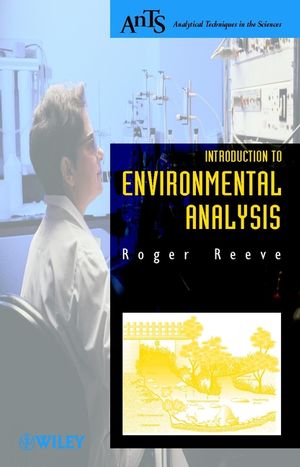Introduction to Environmental AnalysisISBN: 978-0-471-49295-5
Paperback
328 pages
February 2002
 This is a Print-on-Demand title. It will be printed specifically to fill your order. Please allow an additional 10-15 days delivery time. The book is not returnable.
|
||||||
Series Preface
Preface
Acronyms, Abbeviations and Symbols
About the Author
1. Introduction
The Environment
Reasons for Concern
Pollution
The Necessity of Chemical Analysis
2. Transport of Pollutants in the Environment and Approaches to their Analysis
Introduction
Sources, Dispersal, Reconcentration and Degradation
Transport and Reconcentration of Neutral Organic Compounds
Transport and Reconcentration of Metal Ions
What is a Safe Level?
Sampling and Sample Variability
General Apporoach to Analysis
The Choice of Laboratory or Field Analysis
Quality Assurance
3. Water Analysis -
Major Constituents
Introduction
Sampling
Measurement of Water Quality
Techniques for the Analysis of Common Ions
4. Water Analysis -
Pollutants
Introduction
Organic Trace Pollutants
Metal Ions
5. Analysis of Land, Solids and Waste
Introduction
Common Problem Areas in the Analysis of Solids
Specific Considerations for the Analysis of Biological Samples
Specific Considerations for the Analysis of Soils
Speicifc Considerations for the Analysis of Contaminated Land
Specific Considerations for the Analysis involved in Waste and Its Disposal by Landfill
Specific Considerations of Sediments and Sewage Sludge
New Extraction and Dissolution Techniques
6. Atmospheric Analysis -
Gases
Introduction
Determination of Time-weighted Average Concentrations
Determination of Instanteous Concentrations
7. Atmsopheric Analysis -
Particles
Introduction
Sampling Methods
Analytical Methods involving Sample Dissolution
Direct Analysis of Solids
8. Ultra-Trace Analysis
Introduction
Analytical Methods
A Typical Analytical Scheme
Responses to Self-Assessment Questions
Bibliography
Glossary of Terms
Units of Measurement and Physical Constants
Periodic Table
Index
Preface
Acronyms, Abbeviations and Symbols
About the Author
1. Introduction
The Environment
Reasons for Concern
Pollution
The Necessity of Chemical Analysis
2. Transport of Pollutants in the Environment and Approaches to their Analysis
Introduction
Sources, Dispersal, Reconcentration and Degradation
Transport and Reconcentration of Neutral Organic Compounds
Transport and Reconcentration of Metal Ions
What is a Safe Level?
Sampling and Sample Variability
General Apporoach to Analysis
The Choice of Laboratory or Field Analysis
Quality Assurance
3. Water Analysis -
Major Constituents
Introduction
Sampling
Measurement of Water Quality
Techniques for the Analysis of Common Ions
4. Water Analysis -
Pollutants
Introduction
Organic Trace Pollutants
Metal Ions
5. Analysis of Land, Solids and Waste
Introduction
Common Problem Areas in the Analysis of Solids
Specific Considerations for the Analysis of Biological Samples
Specific Considerations for the Analysis of Soils
Speicifc Considerations for the Analysis of Contaminated Land
Specific Considerations for the Analysis involved in Waste and Its Disposal by Landfill
Specific Considerations of Sediments and Sewage Sludge
New Extraction and Dissolution Techniques
6. Atmospheric Analysis -
Gases
Introduction
Determination of Time-weighted Average Concentrations
Determination of Instanteous Concentrations
7. Atmsopheric Analysis -
Particles
Introduction
Sampling Methods
Analytical Methods involving Sample Dissolution
Direct Analysis of Solids
8. Ultra-Trace Analysis
Introduction
Analytical Methods
A Typical Analytical Scheme
Responses to Self-Assessment Questions
Bibliography
Glossary of Terms
Units of Measurement and Physical Constants
Periodic Table
Index



